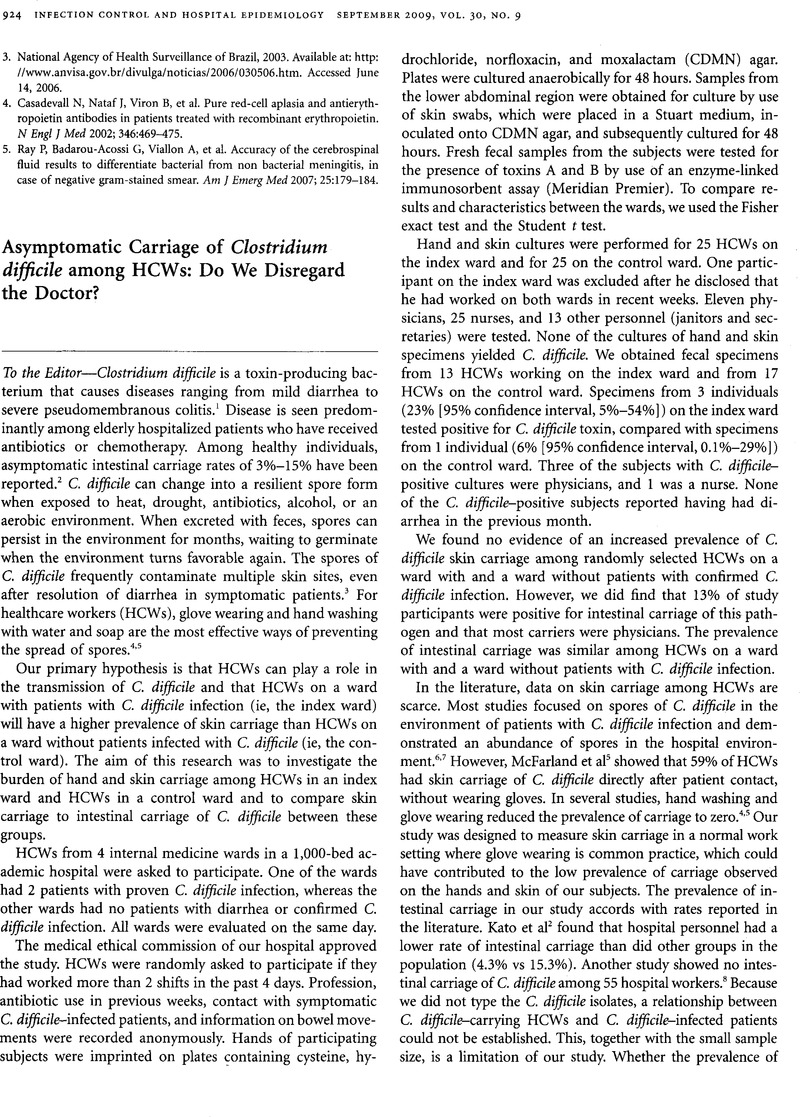Crossref Citations
This article has been cited by the following publications. This list is generated based on data provided by Crossref.
Hell, Markus
Sickau, Kathrin
Chmelizek, Gregor
Kern, Jan Marco
Maass, Matthias
Huhulescu, Steliana
and
Allerberger, Franz
2012.
Absence of Clostridium difficile in asymptomatic hospital staff.
American Journal of Infection Control,
Vol. 40,
Issue. 10,
p.
1023.
Friedman, N Deborah
Pollard, James
Stupart, Douglas
Knight, Daniel R
Khajehnoori, Masoomeh
Davey, Elise K
Parry, Louise
and
Riley, Thomas V
2013.
Prevalence of Clostridium difficile colonization among healthcare workers.
BMC Infectious Diseases,
Vol. 13,
Issue. 1,
Huttunen, R.
and
Syrjänen, J.
2014.
Healthcare workers as vectors of infectious diseases.
European Journal of Clinical Microbiology & Infectious Diseases,
Vol. 33,
Issue. 9,
p.
1477.
Säll, Olof
Johansson, Karin
and
Norén, Torbjörn
2015.
Low colonization rates ofClostridium difficileamong patients and healthcare workers at Örebro University Hospital in Sweden.
APMIS,
Vol. 123,
Issue. 3,
p.
240.
Tian, Tian-tian
Zhao, Jian-hong
Yang, Jing
Qiang, Cui-xin
Li, Zhi-rong
Chen, Jing
Xu, Kai-yue
Ciu, Qing-qing
Li, Ru-xin
and
Deshpande, Abhishek
2016.
Molecular Characterization of Clostridium difficile Isolates from Human Subjects and the Environment.
PLOS ONE,
Vol. 11,
Issue. 3,
p.
e0151964.
Gagneux-Brunon, A.
Lucht, F.
Launay, O.
Berthelot, P.
and
Botelho-Nevers, E.
2017.
Les vaccins dans la prévention des infections associées aux soins.
Journal des Anti-infectieux,
Vol. 19,
Issue. 3-4,
p.
134.
Gagnière, Charlotte
Bourrier, Anne
Seksik, Philippe
Gornet, Jean‐Marc
DeWit, Olivier
Nancey, Stephane
Altwegg, Romain
Abitbol, Vered
Laharie, David
Reenaers, Catherine
Buisson, Anthony
Pariente, Benjamin
Viennot, Stephanie
Vuitton, Lucine
Stefanescu, Carmen
Marteau, Philippe
Bouguen, Guillaume
Cosnes, Jacques
and
Amiot, Aurelien
2018.
Risk of serious infection in healthcare workers with inflammatory bowel disease: a case‐control study of the Groupe d'Etude Thérapeutique des Affections Inflammatoires du tube Digestif (GETAID).
Alimentary Pharmacology & Therapeutics,
Vol. 48,
Issue. 7,
p.
713.
Crobach, Monique J. T.
Vernon, Jonathan J.
Loo, Vivian G.
Kong, Ling Yuan
Péchiné, Séverine
Wilcox, Mark H.
and
Kuijper, Ed J.
2018.
Understanding Clostridium difficile Colonization.
Clinical Microbiology Reviews,
Vol. 31,
Issue. 2,
Gagneux-Brunon, Amandine
Lucht, Frédéric
Launay, Odile
Berthelot, Philippe
and
Botelho-Nevers, Elisabeth
2018.
Vaccines for healthcare-associated infections: present, future, and expectations.
Expert Review of Vaccines,
Vol. 17,
Issue. 5,
p.
421.
Aguirre-García, Gloria M.
Garza-González, Elvira
Morfin-Otero, Rayo
and
Camacho-Ortiz, Adrián
2020.
Clostridioides difficile infections among healthcare workers.
American Journal of Infection Control,
Vol. 48,
Issue. 10,
p.
1270.
Worley, Jay
Delaney, Mary L
Cummins, Christopher K
DuBois, Andrea
Klompas, Michael
and
Bry, Lynn
2021.
Genomic Determination of Relative Risks forClostridioides difficileInfection From Asymptomatic Carriage in Intensive Care Unit Patients.
Clinical Infectious Diseases,
Vol. 73,
Issue. 7,
p.
e1727.
Amandine, Gagneux-Brunon
Gagnaire, Julie
Pelissier, Carole
Philippe, Berthelot
and
Elisabeth, Botelho-Nevers
2022.
Vaccines for healthcare associated infections without vaccine prevention to date.
Vaccine: X,
Vol. 11,
Issue. ,
p.
100168.
Alshannaq, Ahmad F
Kates, Ashley E
Keating, Julie A
Mckinley, Linda L
Dixon, Jonah W
and
Safdar, Nasia
2024.
Diverse Sources and Latent Reservoirs of Community-Associated Clostridioides difficile Infection.
Clinical Infectious Diseases,



